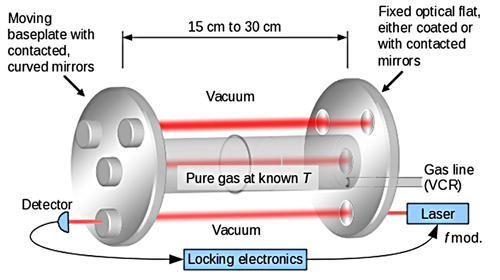Realizing Pressure, Temperature, and Length
Variable-length optical cavity (VLOC):

The primary technique involves building an apparatus to generate and precisely measure equal displacements of Fabry-Perot interferometer mirrors in vacuum and in a helium environment, thus determining refractive index in a manner that allows absolute measurement of pressure or temperature if one of these two quantities is known.
More specifically, the refractive index, n, as measured by the VLOC, is intrinsically related to density such that the refractivity (n-1) depends on P/T, where P is the pressure and T is the temperature. To accomplish our goals, we must compare, with picometer accuracy, results from independent interferometers undergoing large displacements. We expect to achieve ~3 pm uncertainty in the comparison using a novel experimental design and advanced construction techniques.
The basic measurement principle for refractive index is to generate and interferometrically measure identical displacements in a gas and in vacuum. The measured displacement in a gas will appear to be greater than the displacement in vacuum as the non-unity refractive index increases the effective optical pathlength. The refractive index thus can be determined by comparing the measured displacements.
The basic concept behind the proposed apparatus is illustrated in the figure (below at right). The idealized figure shows four Fabry-Perot cavities, each containing a curved and a flat mirror. The design provides a variable-length enclosed path and a displacement of the moving base plate which can be measured by observing the change in resonant frequency of the lasers. The three outer Fabry-Perot cavities are in vacuum, and the central cavity contains ultra-high purity helium gas.
Displacing the moving section without any changes in angular orientation will increase the physical length of all four interferometers by the same amount ΔL. The inner interferometer measures a change in optical length nΔL while the outer interferometers measure ΔL. The difference, (n-1) ΔL, measures the refractivity of helium with an uncertainty goal of ≈1 ppm. The present state of the art for helium refractivity is 1 part in 103. Our refractivity goal corresponds to a refractive index goal of 3 parts in 1011.
By keeping the device at a constant pressure, the measurement of refractive index is not affected by pressure-induced distortions that plague analogous techniques such as dielectric-constant gas thermometry. If temperature is measured, assuming uniformity over the gas to better than 0.2 mK, then the device becomes an optical interferometer manometer (OIM) primary pressure standard.

Fixed-length optical cavity (FLOC) as a transportable pressure standard: A fixed-length optical cavity (FLOC) will have enhanced sensitivity in a greatly simplified package and is very attractive as a transportable OIM pressure standard. The transportable standard would use nitrogen as a working medium because nitrogen has higher refractivity than helium and 2 orders of magnitude less sensitivity to likely contaminants (N2 is also the preferred medium for commercial pressure calibrations). The uncertainty goal (k=1) of the FLOC is 3x10-6 P + 5x10-4 for P in Pa.
Fixed-length cavities are attractive as pressure standards because they can be made from materials with small temporal instability, which can be corrected periodically (zeroed) by a relatively simple measurement of the resonant cavity frequency under vacuum. However, uncertainty in bulk modulus limits the accuracy unless a VLOC can be used to correct for the resulting uncertainty of pressure distortions.
Once the bulk modulus corrections have been assessed, the FLOC becomes a practical optical pressure standard with high sensitivity and stability, delivering an immediate factor of 3 improvement in pressure measurement uncertainties (over existing commercial technologies) for low pressures below 140 Pa. There are also approaches to improved pressure measurements down to as low as 1 Pa.
Both the FLOC and VLOC can be deployed as OIMs and operate at pressures up to 400 kPa (approximately 4 atm), allowing replacement of all mercury based pressure standards.
New methods for temperature measurement:
As noted above, the refractive index, n, as measured by the VLOC or FLOC, is intrinsically related to density or P/T. We envisage an evolution in how the device will relate to temperature measurement. We will first perform measurements at the triple point of water (TPW; T = 273.16 K by definition). However, pressure measurement is typically done at room temperature, requiring realization of thermodynamic temperature near 23 °C with lower uncertainty than has been achieved at the current time (near 1 mK; our goal is 0.15 mK). This can be accomplished by using the VLOC (at the TPW) to calibrate a pressure transfer standard (at 23 °C). The VLOC can then determine temperature at 23 °C if pressure is given by the transfer standard.
The VLOC will thus perform as a thermodynamic thermometer with exceptionally high accuracy. In the future, this approach will be impacted by two expected developments: redefinition of the SI kelvin in terms of the Boltzmann constant; and advances in piston gauges that are expected to improve high-accuracy pressure measurement above 10 kPa (partially overlapping the operating range of our devices). By knowing pressure from the piston gauge, the VLOC can be used to determine thermodynamic temperature at TPW. Following CCT WG-Strategy recommendations, redefinition of the SI, and MeP-K approval, it becomes critical for NIST to be able to claim traceability to the kelvin using a primary thermometer tied to the realization of the Boltzmann constant.
Projected Timeline
This project is in the first year of a five-year research plan. Designs have been drafted for major components and vendors are being sourced. Once the procurement phase is complete, technical aspects of the project will be evaluated and improved.

